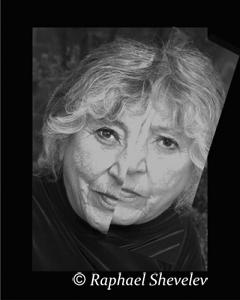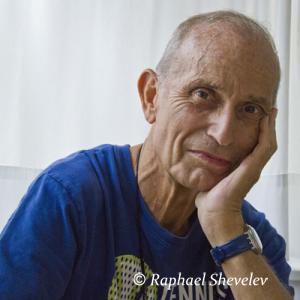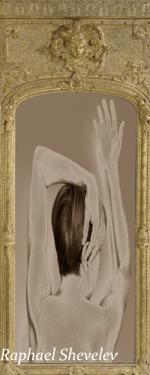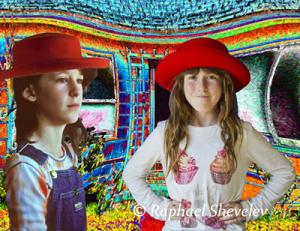Humanity’s major preoccupation is with humanity. We are, so to speak, of the genus homo narcissus, and that describes much of our concerns. Portraiture is the natural result of the urge to record images of ourselves, in all manner of repose and activity. As Remy Saisselin wrote in Style, Truth and the Portrait (1963),
Like all art that has survived, portraiture is bound to history, social conventions, style, and so to time; yet insofar as it may touch us in the present, draw our attention, and set our minds to wonder, it escapes the temporal and is at once of the past as well as the present.
Many years ago I picked up a small, slim volume and opened it at random, coming face to face with a beautiful nineteenth century fin de siècle portrait of my own Eastern European Jewish grandmother as a young woman. But I was quite mistaken, for it was instead a mummy portrait from the middle of the first century A.D., excavated from the Roman cemetery at Hawara, Egypt.
In 1911 Sir Flinders Petrie recovered 146 mummies with portraits, which, like the one of “my grandmother,” are splendid examples of artistic merit. They are very far removed from early pharaonic portraiture, stylized profiles with color applied flatly. Petrie’s discovery showed physiognomically-specific faces with excellent use of light and shade. The subjects are Hellenized individuals who were themselves, or descendants from, Romans, Greeks and Macedonians who had arrived in Egypt as soldiers, administrators, and merchants in the wake of the invasion by Alexander the Great.
Paradoxically, the human need to provide a record of humanity’s stay on earth has suffered from some measure of condescension by artists who sometimes find it demeaning to use their talents to flatter the tastes of a patron. Yet, virtually all of the work of Frans Hals was portraiture, as was much of Rembrandt’s. Both became quite wealthy at this trade. Though both men sought to go beyond physical appearance and reach for what may lie beneath, it had not been until the arrival of Florentine and Venetian painting, that portraitists began to obey Leonardo’s admonition that the painter must depict “man, and the concept of his mind.”
The reasons for our passion to create likenesses in clay and metal, glass and wood, cloth and paper, film, videotape and more recent technologies, are complex, and touch on the very reasons to understand our existence and to seek something beyond likeness itself. That search is fortunately endless, because portraiture finds its best expression in interpreting character, the relationship of the portrayed to their environment and in the passage of the experience between portraitist and subject, all accomplished in the language of design.
Portraitists may wish to honor patrons, to record the affections (or disaffections) of one human for another, to make social and personal comment, or simply to display artistic skill. Confucius encouraged the making of portraits of eminences, in the hope that future generations would have something to emulate. Even now, at a time when some of our environmental din is the incessant clicking of camera shutters, there is still the notion that portraiture singles out subjects as especially worthy of being portrayed. Because of my own predilection of trying to discover something beyond the surface, one of my favorite passages records what Oliver Cromwell is reputed to have said to Sir Peter Lely, painter of the Windsor Beauties:
I desire you would use all your skill to paint my picture truly like me, and not flatter me at all; but to remark all these roughnesses, pimples, warts and everything as you see me, otherwise I will never pay a farthing for it.
As a photographic portraitist, I keep trying to find subjects of similar sensibility. In service to that ambition, and excepting for my grandchildren, I generally try to make portraits of those who have passed the age of sixty, and are quite comfortable living in their own (blemished) skin. I have interest neither in glamor nor in epidermal virginity. I photograph only those with whom I’ve established some form of personal relationship, some trust. The expression of their surprise is my gift to them and their gift to me.
It was King Charles I who realized the political value of grand portraiture, just as present heads of state see the political value of modern imagery. On a visit to Spain, he had seen the royal portraits of Titian and Rubens. Those kings looked like kings. Upon his return to England, Sir Anthony van Dyck was commissioned to paint the equestrian portrait by which we still know him. If the seventeenth century was the age of manners and gesture, the eighteenth became the age of conversation, and with it a form of literature and art, which, trying to penetrate the appearance of courtliness and mask, became an ancestor of modern psychology.
By the beginning of the nineteenth century, portraits of ordinary people no longer looked ridiculous. Whereas in England, portraiture, despite its omnipresence, had generally not been the preferred medium of the artist, in America that situation was reversed, and one can easily conjure social, political and historical reasons. It was the extraordinary talents of Americans Sargent and Whistler, who dominated the last great age of portrait painting.
The invention of photography in 1839 radically changed the nature of portraiture, and the evolution of more modern digital media has revolutionized the nature of photography, and with it, the ability of photography to influence the older media. If photography’s disruption of the painters’ and sculptors’ duopoly in making likenesses, it has forced a sharing of this function with photographers, and has created greater freedom in all media to explore new realms of expression. This same realization, the ease with which the sitter’s physiognomy can be rendered by camera, has likewise imposed new obligations on the photographer. The challenge to all is the need to invest greater ingenuity in pursuit of more than mere likeness. Even a cursory look at the work of Andrew Wyeth, Raphael Soyer, Andy Warhol and French Impressionist Edgar Degas shows how deeply they adopted concepts of photographic vision. Art is neither medium-specific nor medium-exclusive.
Photography is time-based to an extraordinary degree, in which a face, an attitude, an expression, an action can be captured in an instant. That instant is no more important than the receptivity and the creativity of the photographer. Sometimes there are surprises, but luck clearly favors the well-prepared. Now, especially with digital media, in which so much can be done after the initial exposure, the release of the shutter is not a climax, but a precursor. Much labor follows.
Even without the prodigious conceptual and executive talents of photosurrealist Jerry Uelsmann, it is now more easily possible to change relationships with time and place, and even combine elements from different ages, as Rembrandt did in his painting Aristotle Contemplating the Bust of Homer (1653). Rather less well known is my own photograph Mother and Child (2013), which offers a very different sense of time compression, in which both parent and offspring are approximately the same age, depicted together in a fanciful environment.
Photography’s immense success has also overwhelmed us with billions of poor and mediocre images, from the clichés of nature, life-passage photography, and on to the way most parents portray their children as dehumanized, pretty objects, momentarily lobotomized for the glory of the family album. My extreme distaste for the word “cheese” derives from more than my own lactose intolerance.
As I write, The New Yorker, dated September 2nd, has arrived. It contains an elegant article by Anthony Lane titled "Names and Faces: the portraits of Julia Margaret Cameron." She lived in the years 1815-1879 and at 48 was given a camera by her daughter, in the hope that this new apparatus would serve as a genteel hobby. Instead, it became a passion, and, socially well-connected, Julia managed to photograph such people as Tennyson, Longfellow, Browning, Trollope and Darwin, to name a few. She sought the same purpose as other portraitists have done and do. "When I have such men before my camera," she wrote, "my whole soul has endeavored to do its duty toward them in recording faithfully the greatness of the inner as well as the features of the outer man."
Never before has the task of the portraitist been so challenging, or the possibilities so unlimited. All it requires is to stand confidently on a firm foundation of quicksilver.
------------------------------------------------------------------------------------------
Clicking on the images above will take you to their position in the galleries. A second click will enlarge them.
Portions of this column were abstracted from my article "To See Ourselves," pubished in October 1989 by the Journal of the Royal Photographic Society of Great Britain.
_________________________________________________________
© Raphael Shevelev. All Rights Reserved. Permission to reprint is granted provided the article, copyright and byline are printed intact, with all links visible and made live if distributed in electronic form.
Raphael Shevelev is a California based fine art photographer, digital artist and writer on photography and the creative process. He is known for the wide and experimental range of his art, and an aesthetic that emphasizes strong design, metaphor and story. His photographic images can be seen and purchased at www.raphaelshevelev.com/galleries.





Comments
Your work, both writing and
Your work, both writing and photography, is fascinating and unique...as always.
Excellent column, my favorite
Excellent column, my favorite so far in the series. Love the notion of standing confidently on quicksilver. Also fascinated by the time-lapse portrait of Ruth and her daughter. In the last few years I’ve added Thomas Eakins to my list of painters whose work I always look for when in a new museum. I think his portraits provide further example of what you say of Sargent and Whistler.
Your search for that quality
Your search for that quality 'beyond the skin' seems to me the essence of true portraiture. Something that transcends document and biography. Something absolutely authentic to the person, but at the same time deeper and wider than the personal.
A marvelous & erudite piece
A marvelous & erudite piece of writing. You are a complete polymath and the fact that you excel in multiple fields can be summed up in what Leon Battiste said: “A man can do all things if he wills.”
Post a new comment